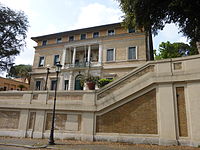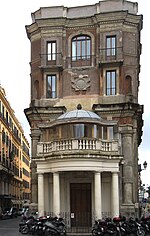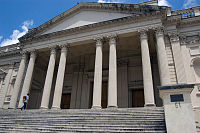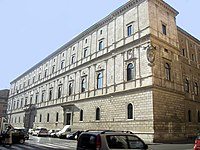| designation
|
founding
|
management
|
history
|
Research priorities
|
image
|
|
Academia Belgica
|
1939
|
Sabine van Sprang
|
|
|

Headquarters of the Academia Belgica
|
|
Académie de France à Rome
|
1666
|
Eric de Chassey
|
|
|
|
|
Accademia di Romania in Roma
|
1922
|
Rudolf Dinu
|
|
|

Headquarters of the Accademia di Romania in Roma
|
|
American Academy in Rome
|
1913
|
Christopher S. Celenza
|
|
|

The American Academy in Rome .
|
|
Bibliotheca Hertziana - Max Planck Institute for Art History
|
1913
|
Tanja Michalsky , Tristan Weddigen
|
|
|

The Mascherone, entrance to the Bibliotheca Hertziana in Via Gregoriana
|
|
British School at Rome
|
1901
|
Stephen J. Milner
|
|
|
|
|
Canadian Academic Center in Italy
|
1978-2002
|
|
|
|
|
|
Český historický ústav v Římě
|
1993
|
Jaroslav Pánek
|
|
|

The Nepomucenum, seat of the Istituto storico ceco di Roma
|
|
Det Danske Institute for Videnskab and Art in Rome
|
1956
|
Marianne Pade
|
|
|
|
|
German Archaeological Institute Rome
|
1829
|
Ortwin Dally
|
Founded in 1829 as Instituto di corrispondenza archeologica . After the management was moved to Berlin in 1832 when Eduard Gerhard left , Rome became part of a larger organization, which was expanded in 1874 when it was converted into a state institution in 1874 with a second foreign department in Athens. Since then, the DAI Rome has finally been part of the German Archaeological Institute with its headquarters in Berlin.
|
In the first decades, material was mainly collected, organized and published. It was not until many decades after its founding that the institute turned increasingly to digging field research. In the second half of the 20th century, the studies, which had previously been aimed at individual regions, such as Rome and its environs, were extended to all of Italy as well as to Tunisia, Algeria and Albania.
|
|
|
German Historical Institute Rome
|
1888
|
Martin Baumeister
|
|
|
|
|
École Française de Rome
|
1873
|
Catherine Virlouvet
|
|
|
|
|
Escuela Española de Historia y Arquelogía en Roma
|
1910
|
Fernando García Sanz
|
|
|
|
|
Institutum Romanum Finlandiae
|
1954
|
Tuomas Heikkilä
|
|
|
|
|
Istituto Storico Cecoslovacco in Roma
|
1923-1939
|
|
|
|
|
|
Istituto Svizzero di Roma
|
1948
|
Michele Luminati
|
|
|

The Villa Maraini in Rome
|
|
Istituto Storico "Fraknói" presso l'Accademia d'Ungheria in Roma
|
|
Eva Vigh
|
|
|
|
|
Koninklijk Nederlands Instituut Rome
|
1904
|
Gert-Jan Burgers
|
|
|

Seat of the Koninklijk Nederlands Instituut Rome
|
|
Norske Institutt i Roma for Art History and Classical Arkeologi
|
1959
|
Christopher Prescott
|
|
|
|
|
Austrian Historical Institute in Rome
|
1881
|
Andreas Gottsmann
|
|
|
|
|
Polska Akademia Nauk Stacja Naukowa w Rzymie
|
1927
|
Leszek Kuk
|
|
|
|
|
Pontificia Accademia Romana di Archeologia
|
1810
|
Letizia Ermini Pani
|
|
|
|
|
Pontificio Istituto di Archeologia Cristiana
|
1925
|
Stefan Heid
|
|
|

The Pontificio Istituto di Archeologia Cristiana
|
|
Roman Institute of the Görres Society
|
1887
|
Stefan Heid
|
|
|
|
|
Svenska Institutet i Rome
|
1925
|
Ulf R. Hansson
|
|
|
|














